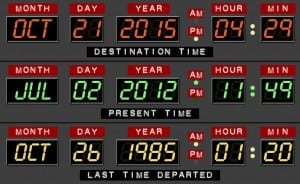“Roads? Where we’re going we don’t need roads.”

Today’s date is October 21, 2015 – the original date of the “future” from the movies. It’s all anyone seems to be able to talk about today, for good reason. The movie introduced plenty of groundbreaking ideas when it first came out – including 3D movies, video chatting, self tying shoes and of course the infamous hover board.
Given the popularity of the film, it is probably not surprising that marketers are clamoring to be a part of the day today with a range of quirky celebratory campaigns. Toyota, Pepsi, Universal Studios and Ford are all brands that have launched some kind of campaign to commemorate the 21st. Outside of all the fictional celebrations, some media properties are also reporting just how much of the technology that was featured in the film may actually be coming tantalizingly close to becoming reality …
Yet whether those predictions come true or not isn’t the most intriguing aspect of the Back To The Future craze. To me the bigger question is why exactly we seem to love it quite so much. Good stories always illicit emotions, but the best do it through memorable details. When people hear a story, they crave this detail. Any literature defining or analyzing storytelling in its many forms from film to poetry will all share the same insight … the details make an emotional difference.

Nostalgia comes from detail, and it can be a powerful thing.
Earlier this year, an insightful marketing article in Marketing Magazine featured a new UK based restaurant called the “Cereal Killer Cafe.” On the menu at the restaurant were all the breakfast cereals with milk that you once had as a kid. They were bringing them out of the home for the first time and letting people enjoy them out and on the go. The restaurant was a huge hit.


Instead, nostalgia works best where there is a truthfulness relative to the original story. The true power of nostalgia is that it lets us remember the emotions of something from the past without trying to reinvent or adapt it for the reality of the present. Nostalgia lets us smile at the often rumored attempts to create self tying laces while enjoying a quiet satisfaction in the reality that where we’re going, we do indeed still need roads.
At least for now.







WE RECENTLY REMOVED COMMENTING - LEARN WHY HERE >